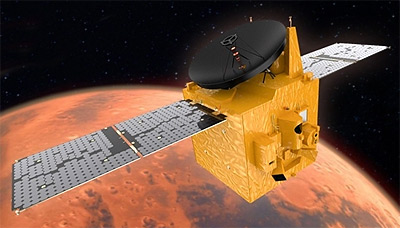Thank you very much for visiting Gunter's Space Page. I hope that this site is useful and informative for you.
If you appreciate the information provided on this site, please consider supporting my work by making a simple and secure donation via PayPal. Please help to run the website and keep everything free of charge. Thank you very much.
Al-Amal (Hope, Emirates Mars Mission, EMM)

Al-Amal (Emirates Mars Mission) [UAE Space Agency]
Emirates Mars Mission (EMM), also known as Al-Amal or Hope, is the first Arab mission to Mars. It was developed at the UAE Space Agency and was built at Mohammed bin Rashid Space Centre (MBRSC).
The Emirates Mars Mission will focus on the Martian atmosphere and climate. It will study how the lower and upper layers of the atmosphere interact with each other. It will search for connections between today’s Martian weather and the ancient climate of the Red Planet.
The Emirates Mars Mission spacecraft is a compact cubic spacecraft built from aluminium in a stiff but lightweight honeycomb structure and surfaced with a strong composite face-sheet. It weighs approximately 1350 kg including fuel, and measure 2.37 m wide by 2.90 m tall. The spacecraft was built at the Laboratory for Atmospheric and Space Physics, at the University of Colorado at Boulder.
The craft will charge its batteries using two 600 Watt solar panels. The solar panel arrays will be folded flat against the sides of the probe for launch, and will unfold once the probe is in orbit.
The spacecraft will communicate with Mission Control by a high-gain antenna with a 1.5 m wide dish. The probe will also have low-gain antennas, which are less directional. Communication bandwidth will be from 1.6 mbs near earth to 250 kbps at Mars.
The 3-axis stabilzed spacecraft will be equipped with star tracker sensors that will help it to determine its position in space by studying the constellations in relation to the sun. For attitude control it will use a set of internal reaction wheels. It will be equipped with two sets of rocket thrusters: four to six large “Delta V” thrusters which are used for orbit insertion and changes, and eight to 12 small Reaction Control System (RCS) thrusters for delicate manoeuvring.
The probe will carry following science instruments:
- EXI (Emirates eXploration Imager) - An multi-band imager designed by Emirati and U.S. engineers at the University of Colorado capable of taking high-resolution images of the Martian surface, with a spatial resolution of better than 8 km in three ultraviolet (UV) and three RGB bands./li>
- EMIRS (Emirates Mars InfaRed Spectrometer) - An Infra-Red Spectrometer developed by Arizona State University which will examine temperature patterns, ice, water vapour and dust in the atmosphere.
- EMUS (Emirates Mars Ultraviolet Spectrometer) - An Ultraviolet Spectrometer designed by Emirati and U.S. engineers at the University of Colorado which will study the upper atmosphere and traces of oxygen and hydrogen further out into space.
Launch took place in July 2020 on a Japanese H-2A-202 rocket and arrival at Mars will be in 2021. It enter an elliptical 22000 km × 44000 km Mars orbit with a 55 day period on 9 February 2021. The mission is planned to last until 2023, with a possible mission extension allowing for a stay until 2025.
| Nation: | United Arab Emirates |
|---|---|
| Type / Application: | Mars orbiter |
| Operator: | UAE Space Agency |
| Contractors: | Mohammed bin Rashid Space Centre (MBRSC), Laboratory for Atmospheric and Space Physics, at the University of Colorado at Boulder (LASP) |
| Equipment: | EXI, EMIRS, EMUS |
| Configuration: | |
| Propulsion: | 4-6 × 120 N thrusters; 8-12 × 5 N thrusters |
| Power: | 3 deployable fixed solar arrays, batteries |
| Lifetime: | 2 years |
| Mass: | 1350 kg |
| Orbit: | 22000 km × 44000 km Mars orbit |
| Satellite | COSPAR | Date | LS | Launch Vehicle | Remarks | |
|---|---|---|---|---|---|---|
| Al-Amal (Hope, Emirates Mars Mission, EMM) | 2020-047A | 19.07.2020 | Ta YLP-1 | H-2A-202 |
References:
- Emirates Mars Mission: Probe
- UAE Space Agency: Details of Emirates Mars Mission
- NASA Spaceflight: UAE-built Mars orbiter arrives at launch site ahead of July liftoff, 26 April 2020
